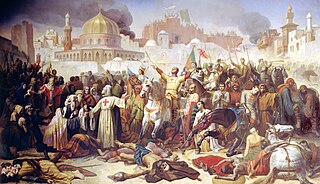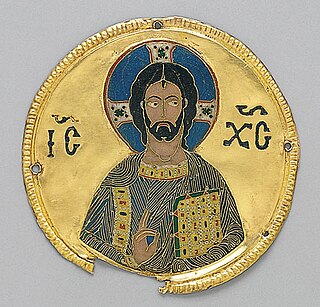Related Research Articles

Bernard of Clairvaux, O. Cist., venerated as Saint Bernard, was an abbot, mystic, co-founder of the Knights Templar, and a major leader in the reformation of the Benedictine Order through the nascent Cistercian Order.

Pope Urban II, otherwise known as Odo of Châtillon or Otho de Lagery, was the head of the Catholic Church and ruler of the Papal States from 12 March 1088 to his death. He is best known for convening the Council of Clermont which ignited the series of Christian conquests known as the Crusades.

The Teutonic Order is a Catholic religious institution founded as a military society c. 1190 in Acre, Kingdom of Jerusalem. The Order of Brothers of the German House of Saint Mary in Jerusalem was formed to aid Christians on their pilgrimages to the Holy Land and to establish hospitals. Its members have commonly been known as the Teutonic Knights, having historically served as a crusading military order for supporting Catholic rule in the Holy Land and the Northern Crusades during the Middle Ages, as well as supplying military protection for Catholics in Eastern Europe.

The First Crusade (1096–1099) was the first of a series of religious wars, or Crusades, initiated, supported and at times directed by the Latin Church in the Middle Ages. The objective was the recovery of the Holy Land from Islamic rule. While Jerusalem had been under Muslim rule for hundreds of years, by the 11th century the Seljuk takeover of the region threatened local Christian populations, pilgrimages from the West, and the Byzantine Empire itself. The earliest initiative for the First Crusade began in 1095 when Byzantine emperor Alexios I Komnenos requested military support from the Council of Piacenza in the empire's conflict with the Seljuk-led Turks. This was followed later in the year by the Council of Clermont, during which Pope Urban II supported the Byzantine request for military assistance and also urged faithful Christians to undertake an armed pilgrimage to Jerusalem.

The Children's Crusade was a failed popular crusade by European Christians to establish a second Latin Kingdom of Jerusalem in the Holy Land, said to have taken place in 1212. Although it is called the Children's Crusade, it never received the papal approval from Pope Innocent III to be an actual Crusade. The traditional narrative is likely conflated from a mix of factual and mythical events, which include the preaching of visions by a French boy and a German boy, an intention to peacefully convert Muslims in the Holy Land to Christianity, bands of children marching to Italy, and children being sold into slavery in Tunis. The crusaders of the real events on which the story is based left areas of Germany, led by Nicholas of Cologne, and Northern France, led by Stephen of Cloyes.

Godfrey of Bouillon was a preeminent leader of the First Crusade, and the first ruler of the Kingdom of Jerusalem from 1099 to 1100. Although initially reluctant to take the title of king, he agreed to rule as prince (princeps) under the title Advocatus Sancti Sepulchri, or Advocate of the Holy Sepulchre.

Raymond of Saint-Gilles, also called Raymond IV of Toulouse or Raymond I of Tripoli, was the count of Toulouse, duke of Narbonne, and margrave of Provence from 1094, and one of the leaders of the First Crusade from 1096 to 1099. He spent the last five years of his life establishing the County of Tripoli in the Near East.
Emicho was a count in the Rhineland in the late 11th century. He is also commonly referred to as Emicho of Leiningen or Emich of Flonheim, and not to be confused with Bishop Emicho of Leiningen. In 1096, he was the leader of the Rhineland massacres which were a series of mass murders of Jews that took place during the People's Crusade.

The siege of Jerusalem marked the successful end of the First Crusade, whose objective was the recovery of the city of Jerusalem and the Church of the Holy Sepulchre from Islamic control. The five-week siege began on 7 June 1099 and was carried out by the Christian forces of Western Europe mobilized by Pope Urban II after the Council of Clermont in 1095. The city had been out of Christian control since the Muslim conquest of the Levant in 637 and had been held for a century first by the Seljuk Turks and later by the Egyptian Fatimids. One of the root causes of the Crusades was the hindering of Christian pilgrimages to the Holy Land which began in the 4th century. A number of eyewitness accounts of the battle were recorded, including in the anonymous chronicle Gesta Francorum.

The siege of Antioch took place during the First Crusade in 1097 and 1098, on the crusaders' way to Jerusalem through Syria. Two sieges took place in succession. The first siege, by the crusaders against the city held by the Seljuk Empire, lasted from 20 October 1097 to 3 June 1098. The second siege, of the crusader-held city by a Seljuk relieving army, lasted three weeks in June 1098, leading to the Battle of Antioch in which the crusaders defeated the relieving army led by Kerbogha. The crusaders then established the Principality of Antioch, ruled by Bohemond of Taranto.

Crusade in Jeans (1973) is a children's novel written by Thea Beckman. It contains a fictional account of the Children's Crusade of 1212, as witnessed by Rudolf Hefting, a boy from the 20th century. The original Dutch title is Kruistocht in spijkerbroek. A film version was released in 2006.

The siege of Jerusalem lasted from 20 September to 2 October 1187, when Balian of Ibelin surrendered the city to Saladin. Earlier that summer, Saladin had defeated the kingdom's army and conquered several cities. Balian was charged with organizing a defense. The city was full of refugees but had few soldiers. Despite this fact the defenders managed to repulse several attempts by Saladin's army to take the city by storm. Balian bargained with Saladin to buy safe passage for many, and the city was peacefully surrendered with limited bloodshed. Though Jerusalem fell, it was not the end of the Kingdom of Jerusalem, as the capital shifted first to Tyre and later to Acre after the Third Crusade. Latin Christians responded in 1189 by launching the Third Crusade led by Richard the Lionheart, Philip Augustus, and Frederick Barbarossa separately. In Jerusalem, Saladin restored Muslim holy sites and generally showed tolerance towards Christians; he allowed Orthodox and Eastern Christian pilgrims to visit the holy sites freely—though Frankish pilgrims were required to pay a fee for entry. The control of Christian affairs in the city was handed over to the patriarch of Constantinople.

Lilies is a 1996 Canadian film directed by John Greyson. It is an adaptation by Michel Marc Bouchard and Linda Gaboriau of Bouchard's own play Lilies. It depicts a play being performed in a prison by the inmates.
The Synod of Jerusalem is an Eastern Orthodox synod held in 1672. It is also called the Synod of Bethlehem.

The Crusades is a 1935 American historical adventure drama film directed and produced by Cecil B. DeMille for Paramount Pictures, loosely based on the life of King Richard I of England during the Third Crusade, and his marriage to Berengaria of Navarre. The film stars Henry Wilcoxon as Richard, Loretta Young as Berengaria, and Ian Keith as Saladin, along with C. Aubrey Smith, Katherine DeMille, Joseph Schildkraut and Alan Hale Sr. in supporting roles.

The Siege of Acre took place in 1291 and resulted in the Crusaders' losing control of Acre to the Mamluks. It is considered one of the most important battles of the period. Although the crusading movement continued for several more centuries, the capture of the city marked the end of further crusades to the Levant. When Acre fell, the Crusaders lost their last major stronghold of the Crusader Kingdom of Jerusalem. They still maintained a fortress at the northern city of Tartus, engaged in some coastal raids, and attempted an incursion from the tiny island of Ruad; but, when they lost that, too, in a siege in 1302, the Crusaders no longer controlled any part of the Holy Land.

The Crusades were a series of religious wars initiated, supported, and sometimes directed by the Christian Latin Church in the medieval period. The best known of these military expeditions are those to the Holy Land in the period between 1095 and 1291 that had the objective of reconquering Jerusalem and its surrounding area from Muslim rule after the region had been conquered by the Rashidun Caliphate centuries earlier. Beginning with the First Crusade, which resulted in the conquest of Jerusalem in 1099, dozens of military campaigns were organised, providing a focal point of European history for centuries. Crusading declined rapidly after the 15th century.

Crusade in Jeans is a 2006 Dutch film directed by Ben Sombogaart. It is an adaptation of the book Crusade in Jeans by Thea Beckman.

Arn: The Knight Templar is an epic film based on Jan Guillou's trilogy about the fictional Swedish Knight Templar Arn Magnusson. The film was released to cinemas in Sweden on 17 December 2007 and the sequel, Arn – The Kingdom at Road's End, was released 22 August 2008, but both films were combined into a single cut for the English release on DVD in 2010. While the film is mostly in Swedish and most of the production was made in Sweden, the film is a joint production between Sweden, Denmark, Norway, Finland and Germany. With a total budget of around SEK 210 million for both films, it is the most expensive production in Swedish cinema. The film grossed $22.5 million according to Box Office Mojo.

Christianity in the 11th century is marked primarily by the Great Schism of the Church, which formally divided the State church of the Roman Empire into Eastern (Greek) and Western (Latin) branches.
References
- ↑ "Awards for Gates to Paradise". IMDb. Retrieved 2 March 2010.
- ↑ "Lost Gems of the '60s: 13th Century Hormones and Rejected Love".